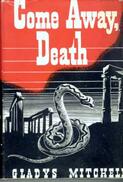ON GREEK TRAGEDY (AND WELSH MARTYRDOM)
Nick Fuller, who provided so much great information to me last time about the Mysteries of Eleusis and the Demeter/Persephone myth, calls our attention to the doomed figures in the House of Atreus:
"The legends of the Atrides hung brooding over the heavy, broken walls of the Lion Gate, and round the unguarded graves. The dark passion of Clytemnestra, the anguish of young Orestes, made heavy the lowering atmosphere, soaked beyond bearing already, with the heat of the dead air before a storm.
Sir Rudri was not [Mrs Bradley's] only source of anxiety. The little boys, bored, and tired… had been by turns listless and tiresome. Alexander Currie had been severely attacked by flies… Armstrong, too, was a perpetual menace… and Gelert had given up any attempt at cheerfulness…"
"In the 13th century, Llywelyn, prince of North Wales, had a palace at Beddgelert. One day he went hunting without Gelert "the faithful hound" who was unaccountably absent. On Llywelyn's return, the truant, stained and smeared with blood, joyfully sprang to meet his master. The prince, alarmed, hastened to find his son, and saw the infant's cot empty, the bedclothes and floor covered with blood. The frantic father plunged the sword into the hound's side thinking it had killed his heir. The dog's dying yell was answered by a child's cry. Llywelyn searched and discovered his boy unharmed but nearby lay the body of a mighty wolf which Gelert had slain. The prince, filled with remorse, is said never to have smiled again. He buried Gelert here. The spot is called Beddgelert."
ON STORY SATISFACTION

From Nick: "The Mycenae section is stifling and oppressive. The attempted sacrifice is one of my favourite scenes in Mitchell; Mrs Bradley, "like some ancient prophetess", menaces Sir Rudri "with her hideous, leering lips". Mitchell often hints that Mrs Bradley is more than mortal. She's compared here to the Pythoness of Delphi; in other books, she's a witch (Tom Brown's Body), or the crone aspect of the Triple Goddess (The Whispering Knights)."
Our previous group of chapters ended with an act of violence against Armstrong, the photographer with blackmailing tendencies, and now, at the end of Chapter 10, there is another moment of impromptu violence, this one involving a knife fight between Gelert and an angry Greek man. Given that pattern, one can reasonably expect Chapter 15 not to end happily…
Another interesting detail is that Gladys Mitchell has purposely varied the size of her chapters here. (In most of her mysteries they are fairly uniform.) Martyn observes that "a formal pattern is suggested by the lengths of the chapters. Up to now, they have been long and leisurely, subdivided into numbered sections. Now, suddenly, in this tenth chapter, it is all over after just four pages. The preceding chapter also stretched to only six. Glancing ahead (without reading!), Chapter 11 reaches up to nine, Chapter 12 makes it to five at a pinch, Chapter 13 hardly gets to page 3, while Chapter 14 recovers to achieve a more familiar extent. Does this compression portend an acceleration of action, of significant events, of that long-awaited crime?"
More from Martyn: "The symmetry of the groups of five chapters and the succession of brief chapters suggest GM is playing with the structure of her tale. It reminded me (vaguely, because I read it long ago in the last century) of Henry Fielding’s Tom Jones where the central chapters of his huge novel cover the shortest periods of time in his narrative – the opening and closing chapters extend over years but at the heart of the book they cover only hours. I may be wrong on the precise timings, but the pattern is definitely there."
ON THE SNAKES AND THE SLEUTH
Martyn adds on: "The short early morning scene with the boys and the snakes makes me feel that GM could have written some great adventure stories for children. Incidentally, Mrs Bradley displays perfect (and fitting) sangfroid in her dealings with the serpents, entering with one coiled about her skinny arm – they even share a similar grin."
My note to Martyn's children story mention: she did write some entertaining, if not too remarkable, adventure stories with young readers in mind. The closest in spirit with the boys of this book may be 1940's The Three Fingerprints, where a trio of curious lads finds themselves investigating Nazi spies and avoiding an alligator in the course of their travels!
Next week we look at Chapters 11 through 15. Fewer pages but closer to that inevitable murder...
 RSS Feed
RSS Feed